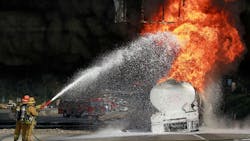MI Officials Phasing out Suppression Foam
Oct. 27 -- TRAVERSE CITY, MI -- A foam used to fight fires contains a contaminant that continues to be found in water supplies across the state. Thousands of gallons sit at fire stations.
The state’s Bureau of Fire Services launched an effort to seek input from Michigan fire departments, using surveys to determine how many use or possess the fire suppression foam — Class B AFFF Foam — that contains perfluoroalkyl and polyfluoroalkyl substances (PFAS). The deadline to submit looms Oct. 31.
State Fire Marshal Kevin Sehlmeyer said officials wait for about 400 more fire departments to respond to the survey, which so far shows about 43 percent of those departments have supplies of the foam. That includes 170 gallons waiting to be used at the Traverse City Fire Department, said Chief Jim Tuller.
The foam currently sits in five-gallon pails, affixed with “Do Not Use” signs, he said.
“I’ve been with the city 28 years and I can’t recall ever using the foam,” Tuller said. “But it’s always one of those tools in the tool box.
“Luckily, we’ve not had a need to use that.”
Sehlmeyer stopped in Traverse City for a discussion with Tuller, Blair Township Fire Chief Bill Parker, Peninsula Township Fire Chief Fred Gilstorff, Michigan Association of Fire Chiefs President Dave Glotzbach and others to discuss the foam and share a plea to the state’s fire departments: fill out the survey.
The completed survey results will supply foam supplies in the state — a number state officials estimate at about 32,000 gallons, according to the latest survey results. Sehlmeyer said researchers continues to set statewide solutions to dispose of and replace those foams.
Practices for disposing of the foam remain under review. Military facilities incinerated their PFAS foam supplies in the past, others mixed it into things like concrete and sent it to hazardous materials landfills.
Legislation could play a role in disposing the foam and helping fire departments replace it with an alternative foam that doesn’t contain PFAS. Work continues to determine what the replacement should be, Sehlmeyer said.
“Can I guarantee 100 percent we'll have funding to replace the foam for you? I can't,” he said to the fire officials gathered.
State officials discovered firefighters used the foam to douse fires in the past and, in some instances, the PFAS sifted into the earth and contaminated water supplies, including in drinking water wells near a plume at the site of a 1995 fire in Blair Township.
The blaze for 20 days burned at the former Carl’s Retreading used tire site, while firefighters used the foam to suppress it. Residents in a neighborhood near the site are finding remnants of it in their drinking water more than 20 years later.
Michigan Department of Environmental Quality sampling efforts Aug. 6 confirmed nine nearby wells tested positive for low levels of PFAS, prompting residents to avoid consuming the tap water, using bottled water to drink, cook and brush teeth.
All of the tests came in below the Environmental Protection Agency’s 70 parts per trillion cutoff.
Officials additionally found the contaminant in the Leland Public School water supply at 7 parts per trillion levels.
Sehlmeyer said DEQ officials are nearly finished testing public water supplies statewide for PFAS. He expects that effort to conclude by Christmas. The testing included schools on well water.
State officials are not calling on fire departments to stop using the foam altogether. It could be a necessity for fighting fires involving hydrocarbons, alcohol or aviation equipment, he said. Federal Aviation Administration officials additionally require airports use the foam, Sehlmeyer said.
Fire officials typically communicate with DEQ officials after fires. Now officials “changed protocol” to require the DEQ officials to question whether firefighters used the foam during the blaze. If they did, then a third party crew would come in for a cleanup of the foam, Sehlmeyer said.
Glotzbach said letting the flames burn out sometimes could be a better option than using the foam and sending PFAS into the ground.
Everyone gathered at the table Friday shared concern for the impacts using the foam could bring. They appeared happy to be addressing the dangers while looking to take it out of service.
“It's a positive move and everyone is working toward this,” said John Kramer, a fire chief in Bay County. “We're greatly concerned for the community, for our environment, because it affects everybody.”
___ (c)2018 The Record-Eagle (Traverse City, Mich.) Visit The Record-Eagle (Traverse City, Mich.) at record-eagle.com Distributed by Tribune Content Agency, LLC.
